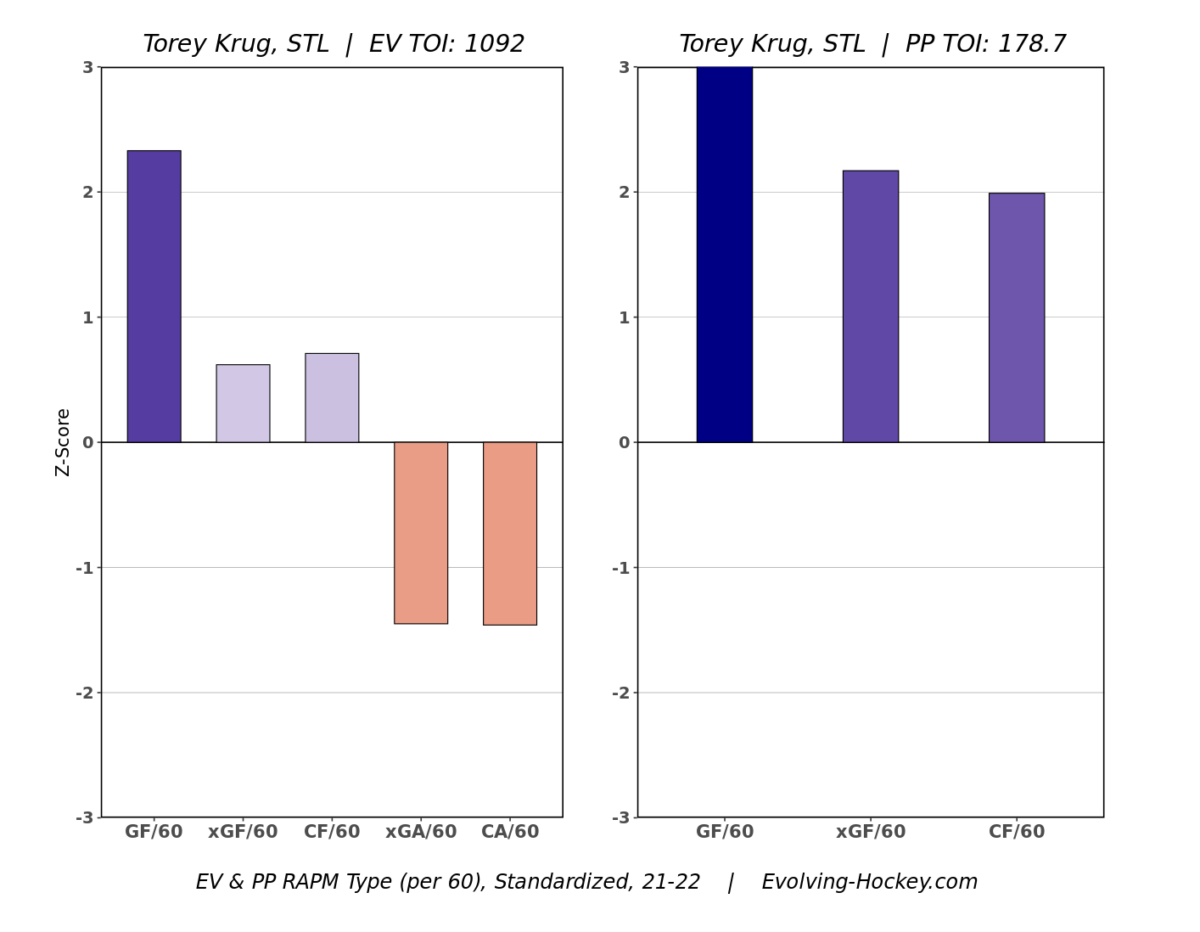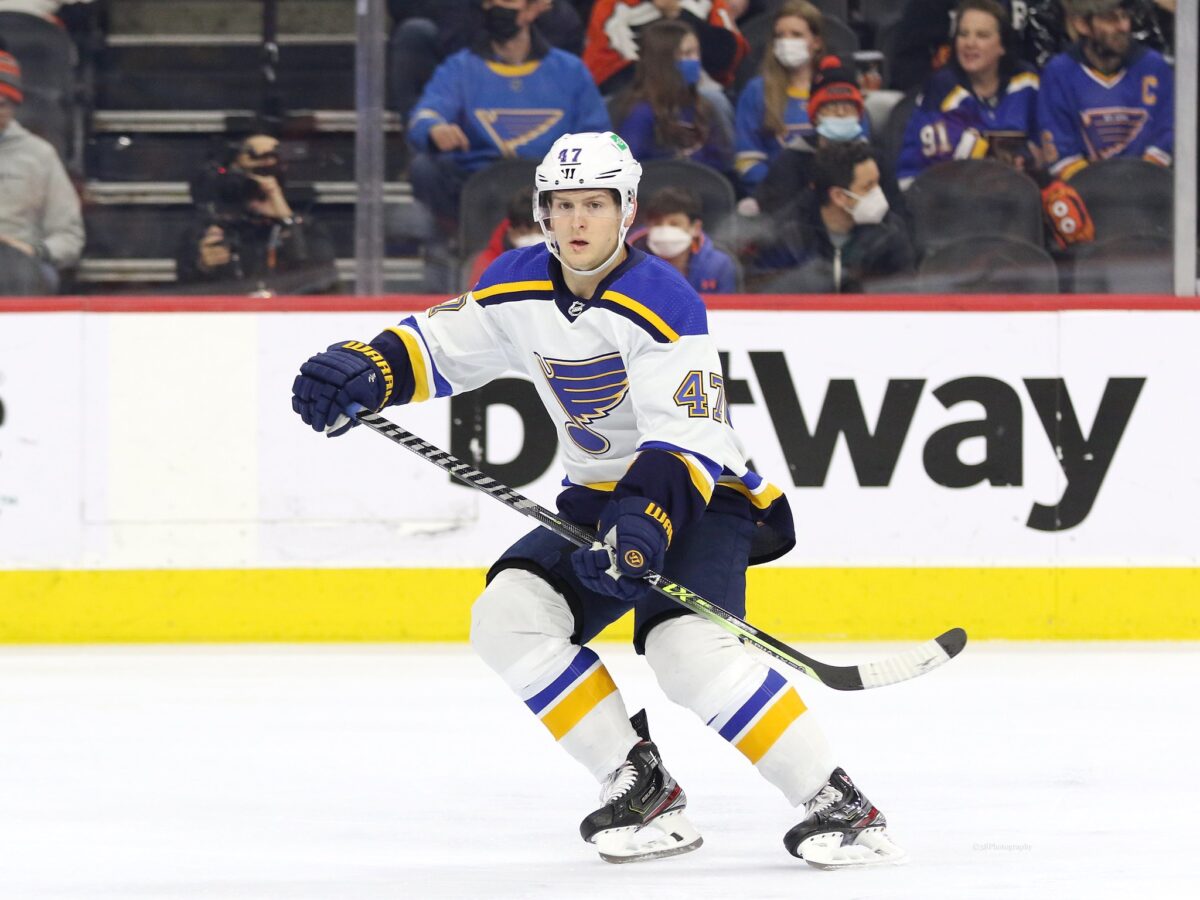The St. Louis Blues 2021-22 season represented a major transition for the franchise. No longer a stout defensive team built from the blueline out, they finished second in the NHL in goals scored, with nine forwards recording 20-plus goals. Though the season came to an end in a six-game defeat by the Colorado Avalanche in the second round, there are plenty of highs and lows to reflect on. In this series, we’ll evaluate each player who played 10 or more games with the team (as well as the head coach and general manager), grading their individual performance and looking at their future with the team.
Coming off an inconsistent first season with the Blues, Torey Krug entered the 2021-22 campaign with a lot to prove. The Blues signed him to a seven-year, $45.5 million immediately before former captain Alex Pietrangelo departed for the Vegas Golden Knights, which immediately burdened Krug with unfair expectations from Blues fans. Starting with a clean slate in the 2021-22 season gave him a chance to prove that he has a lot to offer St. Louis. Let’s take a look at how he did.
What Went Right: Offensive Excellence
As ever, Krug proved that he is an excellent offensive defenseman. He led Blues defensemen in points per game (0.67) and notched nine goals to go along with 34 assists. He also led Blues defensemen in expected goals for percentage (xGF%) at 52.72%. That metric measures the balance of play and scoring chances when a given player is on the ice. Statistics suggest that Krug is an elite puck possessor and a borderline game-breaking offensive defenseman.

Krug’s superlative play extended to the power play, where he led the team in time on ice (TOI). He led Blues defenders in power play goals and assists, and his 16 power play assists ranked second only behind Vladimir Tarasenko on the entire team. By every measure, Krug was a strong offensive defender at even strength and an outstanding one with the man advantage. That should be exactly what the Blues expected when they signed him.
What Went Wrong: Playoff Exit, Defensive Questions
The worst part of Krug’s season came in Game 3 of the playoffs during a collision with the Minnesota Wild’s Matthew Boldy. As Boldy attempted to pull up and turn on a dime, Krug tried to dodge out of the way, only for the forward to collide with his left leg. With his skate planted firmly in the ice, his knee bent awkwardly and he left the game. On sight, it was clearly a serious injury. The Blues acknowledged he would be out for a while, but that while became the rest of the postseason. It seems like the injury wasn’t more serious, fortunately, as head coach Craig Berube hinted that Krug was on the verge of a return near the end of the postseason. But it was tough for the team to lose him for the playoffs.

When looking at what else went wrong for Krug this season, it’s hard to overlook the questions that remain about his defensive contributions. As the RAPM chart shared earlier demonstrates, Krug allows a significant amount of scoring chances and expected goals for a top-four defenseman. But that shouldn’t be news to anyone. He is a slightly below-average defender and a significantly above-average offensive threat. The Blues must have known that when they signed him.
Key Facts
- Led Blues players in power play TOI, with 2:48 per game
- Led Blues defensemen in points per game (0.67)
- Led Blues defensemen in xGF% (52.72%)
Final Grade: B+
Some Blues fans will never become Krug converts. St. Louis has always gravitated to gritty, blue collar, defense-first players, and he simply doesn’t fit that mold. But much like you can’t ask a leopard to change his spots, you shouldn’t ask an extraordinary puck-possessing defender to become a shutdown blueliner. If the Blues expected anything else, they should never have signed Krug in the first place. But general manager Doug Armstrong seems to have known what he was doing, and clearly believes that Krug can be a major part of the Blues’ transforming identity.
Related: Blues Forward Depth is Team’s Greatest Strength
Krug excelled offensively and held his own defensively. He quarterbacked the second-best power play in the NHL and led the team’s defenders in several key offensive categories. He missed most of the postseason, through no fault of his own, but he and defensive partner Justin Faulk became the team’s most significant defensive pairing, and you can’t ask for much more.
What’s Next for Krug?
Krug has five seasons remaining on his current contract, with a no-trade clause (NTC) to boot. He’s not going anywhere. The biggest questions for him this offseason will be whether he’s fully healthy after his scary collision with Boldy, and who, if anyone, Armstrong will go out and get to supplement the left side of his defense. If his GM can find a stalwart defender to pair with Parayko on the left side, there will be even less pressure on Krug to be a shutdown defender. That could free him up to be even better and more impactful in the seasons ahead.